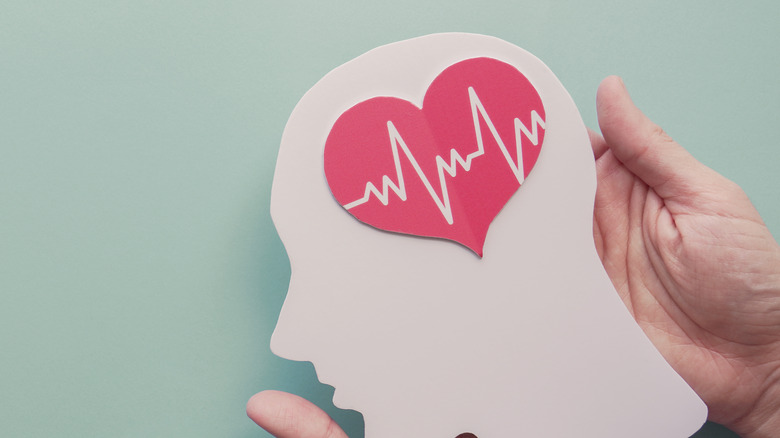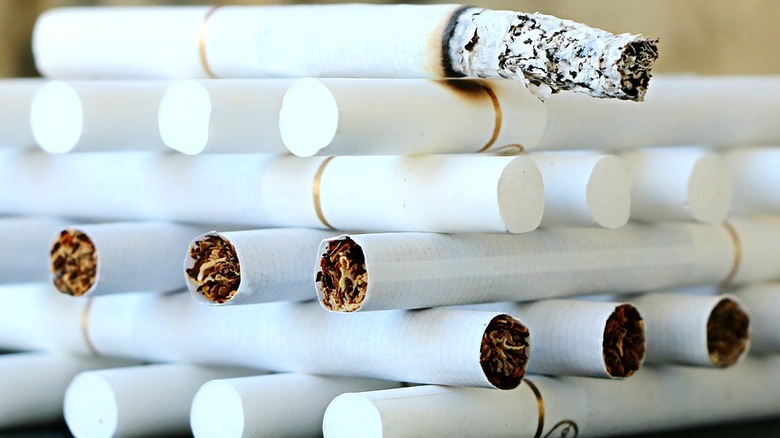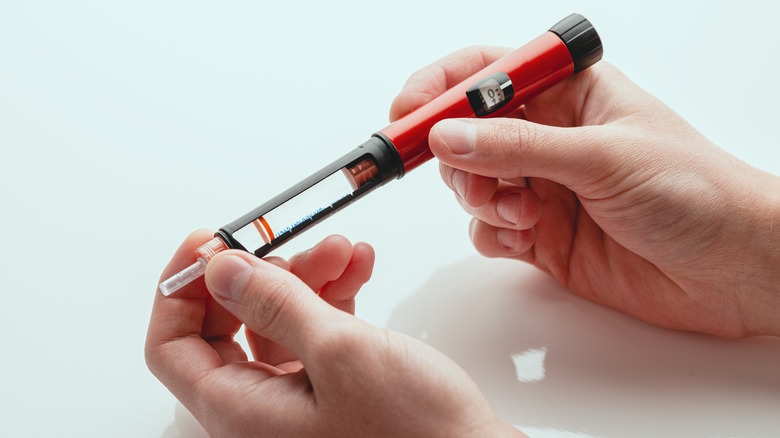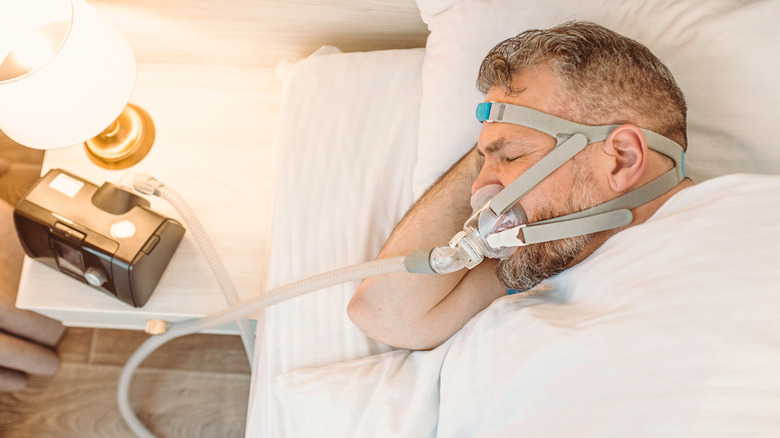What You Can Do To Decrease Your Risk Of A Stroke
If you're wondering what you can do to decrease your risk of a stroke, you're not alone. According to the American Stroke Association, stroke is the 5th most common cause of death in the United States. About 800,000 people experience a stroke every year in the U.S. (per the CDC). What's more, the CDC goes on to say that 80% of these strokes — the vast majority — are preventable.
So, there's good reason to consider what you can do to prevent a stroke. This applies to everyone, but it's especially true if you've already experienced a stroke. In fact, the Cleveland Clinic claims that 25% of strokes are not the first stroke the patient has had. As stated by neurologist Blake Buletko, MD of the Cleveland Clinic, "Your risk of a second stroke is highest in the first two days," but you'll remain at an increased risk for a few months or even up to a year.
Thankfully, we can do something about the estimated 80% of preventable strokes. Both the CDC and the Cleveland Clinic point out that many lifestyle factors raise your risk of having a stroke. These are things that are within our control, such as diet, exercise, and smoking habits. Changing your habits is never easy, but it's worth trying if it can help prevent stroke. Start with a few small changes and gradually work your way towards more, to keep your habit change sustainable.
What is a stroke?
Sometimes called a "brain attack," a stroke happens when blood flow to the brain is disrupted (per WebMD). This is caused by one of two things: A blood vessel is either blocked by a blood clot (ischemic stroke) or it bursts (hemorrhagic stroke). The American Stroke Association identifies ischemic stroke to be the most common type of stroke, accounting for 87% of all cases.
The primary cause of ischemic stroke is atherosclerosis, or fatty plaque buildup in the blood vessels. The American Stroke Association goes on to explain two different ways in which fatty plaque can cause a stroke. Cerebral thrombosis refers to a blood clot developing from the fatty plaque in a blood vessel, while cerebral embolism refers to a blood clot developing elsewhere and breaking off, traveling through the bloodstream and eventually blocking a blood vessel.
A hemorrhagic stroke happens when a blood vessel in or near the brain ruptures. Cedars-Sinai lists a number of potential causes including traumatic head injury, but the most common cause is hypertension or high blood pressure (per the American Stroke Association). This is also a major risk factor for ischemic stroke. Many of the risk factors for both types of stroke are the same, and having one stroke increases your risk for another (per the Cleveland Clinic). With this in mind, it's a good idea to be familiar with the risk factors.
Healthy living habits and medical history both play a role
Your medical history and past health conditions contribute to your risk of having a stroke, but there are also a number of lifestyle habits that play a role. The Mayo Clinic separates these risk factors into two lists: medical risk factors and lifestyle factors. The medical risk factors include things like high blood pressure, high cholesterol, diabetes, and personal or family history of stroke. Meanwhile, the lifestyle risk factors listed by the Mayo Clinic include physical inactivity and heavy drug use, but as we'll soon see, this is not a comprehensive list of all the lifestyle risk factors that contribute to having a stroke.
It makes sense to separate the risk factors into these two categories, given that our habits are more in our control than our history. However, it's important to understand that just because something is classified as a "medical risk factor" does not mean it's completely out of our control. In order to decrease your risk for a stroke, you can work on habits that are within your control, as well as make sure to treat or manage any medical conditions that raise your risk for a stroke. Of course, it's a good idea to treat any medical conditions you have anyway, whether or not you're concerned about a stroke.
Healthy living habit: Eat whole, minimally processed foods
One of the best things you can do to help prevent a stroke is to eat whole, minimally processed foods. A systematic review from PLoS One identified fruits, vegetables, nuts, seeds, whole grains, fish, and yogurt as having a protective effect against a variety of cardiovascular diseases, including stroke. A stroke is a type of heart disease (according to the NY Department of Health), but these foods will also help to protect against other heart diseases as a bonus, including coronary heart disease and other types of heart failure.
The systematic review from PLoS One also identified a number of nutrients that were associated with a lower risk of cardiovascular diseases, including fiber, omega-3s, polyunsaturated fasts, and potassium. Note that the foods as well as the nutrients that the researchers identified as having a protective effect against cardiovascular diseases are abundant in the Mediterranean diet, a lifestyle diet that emphasizes whole plant foods and fish. The Mediterranean diet can help reduce your risk for a variety of other health conditions besides stroke and other cardiovascular diseases, such as cancer, Alzheimer's disease, Parkinson's disease, and overall mortality (according to a meta-analysis from the British Medical Journal).
Healthy living habit: Limit red meat and highly processed foods
In addition to eating more healthy foods that protect against disease, it is also important to limit foods and nutrients that are known to increase your risk of disease. A systematic review from PLoS One lists unprocessed red meats, processed meats, sugar-sweetened beverages, trans fats, and sodium as the foods and nutrients that most significantly raise your risk for developing cardiovascular diseases (including stroke). Unprocessed red meats include beef and pork, while processed meats include bacon, sausage, ham, pepperoni, salami, hot dogs, and most deli meats. Sugar-sweetened beverages refer to soda, sweetened tea, and any other drink with added sugar. (Many juices also have added sugar.) Meanwhile, trans fat is a manufactured ingredient also known as "partially hydrogenated oil" (according to the Mayo Clinic), and it can be found in many highly processed foods, as can sodium.
Note that red meats and processed meats increase your risk for a variety of other health conditions besides stroke and other cardiovascular diseases. A meta-analysis from Nutrients found that both red meats and processed meats could raise the risk of developing gastric cancer. Additionally, the FDA determined in 2015 that partially hydrogenated oils (trans fats) were not "generally recognized as safe," and that removing these from processed foods "could prevent thousands of heart attacks and deaths each year."
Healthy living habit: Get some physical activity
Physical activity is known to have a whole host of health benefits, one of which is a reduced risk of stroke. The Stroke Association advises being as physically active as you're able to in order to lower the chances of developing a stroke. Physical activity can help to prevent not just stroke, but other forms of cardiovascular disease as well, according to a systematic review and meta-analysis from the Journal of the American Heart Association. The study also mentions the protective effect of exercise against type 2 diabetes.
Interestingly, the researchers specifically note that the biggest boost to your health if you are inactive will come from adding small amounts of physical activity. It's true that even a little physical activity is better than none — and it's more likely sustainable and manageable than trying to do too much, especially for a person whose current activity levels are zero.
This is true even if you have already had a stroke. While it needs to be done safely, high-intensity exercise can help stroke survivors recover and improve their cardiovascular health, as found by a systematic review and meta analysis from the Annals of Physical and Rehabilitation Medicine. According to the researchers, high-intensity exercise didn't appear to increase the risk of a fall, skin injuries, or pain, suggesting it likely has few adverse effects.
Healthy living habit: Limit alcohol
The Mayo Clinic lists "heavy or binge drinking" as one of the major lifestyle risk factors that contribute to stroke, as well as the use of certain illegal drugs such as cocaine and methamphetamines. The CDC also identifies excessive alcohol consumption as a risk factor for stroke, in part because it can raise your blood pressure (which increases your risk for a stroke, per the American Heart Association). The CDC recommends that men limit themselves to two drinks per day, while women should limit themselves to one.
The Stroke Association specifically mentions atrial fibrillation, or an irregular or very rapid heart beat (per the Mayo Clinic), as a condition that quintuples your risk for a stroke — and excessive alcohol consumption can lead to atrial fibrillation. This is one avenue through which drinking too much alcohol can increase your risk of a stroke, but it isn't the only one. The Stroke Association also mentions that alcohol can raise your blood pressure, and it can also increase your risk of developing diabetes, which in turn is also associated with an increased risk of developing a stroke. Additionally, they highlight the connection between certain medications known to be blood-thinners (such as aspirin) and alcohol, which have the potential to interact.
It's a good idea to speak with your doctor or healthcare provider if you have been prescribed or regularly take a blood-thinning medication, and are wondering whether or not you can drink.
Healthy living habit: Avoid cigarettes
You are no doubt already aware of some of the medical conditions associated with cigarette consumption. That cigarettes raise our risk for lung cancer is common knowledge, but did you know they also raise our risk for developing a stroke?
The U.S. Department of Health lists quitting smoking as one of the most effective ways to decrease the likelihood of having a stroke. The Stroke Association also highlights the connection between smoking cigarettes and experiencing a stroke. They note that strokes are twice as likely to be fatal among regular cigarette smokers, and that there is a linear relationship between smoking cigarettes and risk of stroke: The more cigarettes you smoke per day, the greater your risk. They go on to explain that tobacco smoke thickens the blood, makes blood clots more likely, narrows the arteries, and restricts the oxygen in blood — all of which make a stroke more likely.
The Stroke Association also mentions that smoke from tobacco has over 7,000 toxins in it, including carbon monoxide, arsenic, and cyanide. When you smoke cigarettes, these toxins get into your bloodstream, wreaking havoc on your cardiovascular health. For these and other reasons, it's a good idea to quit smoking in order to decrease your risk of developing cardiovascular diseases, including stroke.
Healthy living habit: Avoid e-cigarettes
If you're already aware of the negative effects of cigarette smoking on your cardiovascular health, you might think e-cigarettes are a better option. Unfortunately, switching from cigarettes to e-cigarettes does not seem to reduce your risk of cardiovascular outcomes, according to a systematic review from the Harm Reduction Journal. The researchers note that "cardiovascular outcomes" include stroke, myocardial infarction (heart attack), and coronary heart disease. In other words, e-cigarettes may contribute to your risk of developing a stroke (or a heart attack, or heart disease) just as much as regular cigarettes.
The systematic review from the Harm Reduction Journal does note, however, that respiratory outcomes (including chronic bronchitis and asthma) were 40% less likely among those who switched from cigarettes to e-cigarettes. That said, just because the odds of developing these conditions were lower doesn't mean that e-cigarettes don't raise your risk of developing them at all — just that the risk is a bit lower than the one associated with regular cigarettes.
Additionally, the American Lung Association points out that e-cigarettes raise your risk of developing lung cancer and other lung diseases in part because of the additives used to make the vaporizable liquid. In general, vaporizers are still very new, and it may be a good idea to avoid or limit their use until we know more about which additives are safe (if any).
Healthy living habit: Manage stress
An often-overlooked risk factor of a variety of other health conditions is chronic stress (per Yale Medicine). In fact, "perceived psychosocial stress" is associated with an increased risk of developing a stroke, according to a meta-analysis from BMC Neurology. This meta-analysis included studies that measured general stress, work stress, and stressful life events via survey data, and found a 33% increased risk of stroke among those who reported psychosocial stress.
The Heart and Stroke Foundation of Canada explains one way in which this happens: Stress causes a rise in blood pressure as well as blood sugar. If this happens regularly, it's easy to see how it could create problems. High blood pressure is known to increase your risk of a stroke (per the American Stroke Association), and regularly experiencing a spike in your blood sugar has the potential to lead to diabetes, which can also lead to stroke.
Of course, stroke is not the only thing you have to worry about when dealing with chronic stress. A meta-analysis from Oxidative Medicine and Cellular Biology suggests psychological stress could be a risk factor in a number of different types of cancer. For the sake of your health, it's a good idea to manage any chronic stress in your life. There are many ways to combat stress: Consider what helps you relax and unwind, and make time for this kind of self-care every day.
Medical history: Check cholesterol
High levels of serum cholesterol (the cholesterol in your blood) raise your risk of developing a stroke, according to the Mayo Clinic. For this reason, it's important to get regular blood tests so you can identify this problem early. The Mayo Clinic goes on to explain that high levels of serum cholesterol translate to the buildup of fatty plaque in blood vessels, restricting blood flow and potentially causing a blood clot. This can lead to either stroke or heart attack, depending on where exactly the blood clot forms.
Cholesterol is actually found in your cells, and it's used to produce certain hormones — but your body makes all the cholesterol it needs (via MedlinePlus). Where cholesterol causes problems is in your blood, and it ends up in your blood when you consume excess cholesterol from your diet (per Johns Hopkins Medicine). The Mayo Clinic also lists specific foods to avoid in order to lower your cholesterol, including fatty meats, dairy, and other sources of animal fat. They also mention that fruits, vegetables, and whole grains can help to lower your cholesterol.
Consider speaking with your doctor or healthcare provider to schedule regular blood work so you can keep your serum cholesterol levels in check (if you aren't doing this already).
Medical history: Check blood pressure
According to the American Heart Association, hypertension or high blood pressure is one of the major risk factors of developing a stroke. This is because high blood pressure can damage your arteries, and weakened arteries create conditions that make a stroke much more likely.
The CDC explains in detail how this happens: High blood pressure increases tension in the walls of the arteries, which can decrease their elasticity, which in turn decreases blood flow and can lead to a variety of heart problems. The heightened pressure against the arteries can also cause them to burst or become obstructed, leading to a stroke.
Because high blood pressure is associated with many health conditions apart from stroke (such as heart problems, per the CDC), it's important to test your blood pressure regularly. You can do this at a doctor's office or at many pharmacies. If you do have high blood pressure, there are many things you can do to try to lower it. The CDC lists eating a healthy diet, keeping chronic stress under control, and avoiding smoking as some of the ways you can lower your blood pressure naturally. If you try these strategies and continue to have high blood pressure, talk to your doctor, as you may require medication.
Medical history: Treat diabetes
Diabetes can increase your risk of developing a stroke. According to WebMD, high blood sugar can increase your risk of having a stroke by a factor of at least 2 and possibly up to 4. They explain that if diabetes isn't monitored or managed, it can lead to fatty plaque in your blood vessels, potentially leading to a blood clot and causing a stroke.
The Cleveland Clinic explains in detail how diabetes can lead to a stroke. Diabetes causes your body to become insulin-resistant, which triggers the buildup of sugar (glucose) in the blood. Over time, this unchecked high blood sugar can damage blood vessels, and damaged blood vessels can increase the risk of a stroke. The Cleveland Clinic also notes that diabetes is associated with a number of other health conditions that increase your risk for a stroke, including high blood pressure, heart disease, and high cholesterol.
If you have diabetes or believe you are at risk for developing diabetes, make sure you have a good treatment plan that keeps your blood sugar in check, and get regular blood work done so you can monitor the disease. Talk to your doctor or healthcare provider to make sure you are doing everything you can to limit your risk of a stroke while managing diabetes.
Medical history: Treat heart disease
Diseases of the heart, including coronary heart disease, can increase your risk of developing a stroke. This makes sense, given that stroke itself is a type of cardiovascular disease (per the NY Department of Health). The same mechanisms that cause heart disease — high serum cholesterol, high blood pressure, weakened blood vessels, etc. — all contribute to stroke (via the CDC).
In fact, according to the U.S. Department of Health, heart disease is the "leading cause of death in the United States," while stroke is the number 5 most common cause of death. Diagnosing and treating heart disease is obviously important for your overall health as well as your lifespan, regardless of the increased risk of developing a stroke.
If you've been diagnosed with any sort of heart disease or heart condition, make sure you are treating it as well as you can. Thankfully, you can treat heart disease with many of the same lifestyle changes that are recommended to help prevent stroke. According to the Mayo Clinic, these lifestyle changes include eating a healthy diet, getting plenty of exercise, quitting smoking, limiting alcohol consumption, and taking any medications that have been prescribed for your heart. Schedule regular appointments with your doctor or healthcare provider to make sure you are keeping any heart conditions in check.
Medical history: Treat sleep apnea
According to a review from Current Opinion in Neurology, sleep apnea is a "well established independent risk factor for stroke" that makes you approximately twice as likely to experience a stroke. The researchers also note that sleep apnea is a common post-stroke complication, implying that the causation can go in both directions. In other words, sleep apnea increases your risk for a stroke, but having a stroke also increases your risk for sleep apnea.
A study from Sleep Medicine and Disorders notes that obstructive sleep apnea increases your risk of having a stroke. However, it also connects obstructive sleep apnea to a variety of other health conditions, including high blood pressure, cardiovascular diseases, atrial fibrillation, type 2 diabetes, chronic stress, and smoking cigarettes. Important to note is that all of these conditions also independently raise your risk of having a stroke. So, sleep apnea may increase your risk of a stroke directly, and it may also increase your risk of a stroke by increasing your risk of a variety of other medical conditions that can raise your risk of a stroke.
If you have obstructive sleep apnea, talk to your doctor or healthcare provider to make sure you are treating it and keeping it in check. Doing so will not only improve your sleep — it will also help reduce your risk of myriad other health conditions.















